Gamification Marketing: Using Game Elements To Motivate Customers
“Gamification marketing” is one of those terms that has been bandied around in recent years. It’s not hard to see why. Used properly, gamification marketing can be a powerful tool to tap into customers’ motivations and create immersive experiences that keep them coming back.
Top brands, including Nike, Starbucks, and McDonald’s, have already taken advantage of this concept with amazing results.
But what is gamification about? More importantly, how can you incorporate it into your brand’s marketing strategy? Here’s what you need to know.
Table of Contents
- What is gamification marketing?
- Psychology of gamification marketing
- Elements of gamification in marketing
- Implementing gamification marketing
- Measuring the success of your gamification efforts
- Gamification marketing case studies
- Gamification with Mambo.io
- Key takeaways
- Closing thoughts
- Machine Learning In Finance: 12 Essential Applications
- How To Create Interactive Compliance Training For Bank Employees
- How Fintech Apps Are Using Gamification To Increase User Engagement
- Top Gamification Companies for Employee & Customer Engagement
Download your free
“Gamification Guide”
Get your PDF now and start transforming your approach to digital engagement!
What is gamification marketing?
Gamification marketing is a specialised form of marketing that leverages game-like elements to attract and engage customers. Basically, take several game designs and components and incorporate them into a non-gaming context, like an email, landing page or website.
Now, “specialised” is a bit of a strong word, especially since it’s actually not that difficult to introduce gamification to your marketing strategy. Still, it isn’t your standard marketing technique and does require a professional touch to execute correctly.
In gamified marketing, the target audience presents with interactive elements that drive them to perform specific actions. Each completed action comes with some form of incentive for the customer.
For example, brands can apply gamification in marketing to their email campaigns by including scratch-off tickets or coupons. The recipients then virtually “scratch off” the tickets using their cursor (or fingers when using their phones) to reveal the reward.
Right away, you can see why it works. Scratching off the ticket represents strong user engagement. It shows that people are taking time to complete an action that you want them to complete. It’s memorable. People receive several emails daily, but how many offer interactive content with real rewards?
Psychology of gamification marketing
As of 2015, the average human attention span was just over 8 seconds. This is an important metric for businesses, especially regarding their marketing strategies. One way to capture and retain your audience’s attention is through gamification.
At its core, gamification marketing is about motivating prospects and customers to act. The actual process might differ with potential and returning customers, but the goal is essentially the same.
Motivation is a psychological state that drives individuals to take action toward a desired goal or outcome. There are two main types of reasons to consider here:
- Intrinsic motivation — As the name suggests, this motivation comes from within. Intrinsic motivation is associated with inherently enjoyable, engaging, or satisfying activities. It is driven by factors such as a sense of autonomy, mastery, and purpose.
- Extrinsic motivation — This motivation comes from external factors such as rewards, recognition, or social status. It is often associated with activities for a specific outcome or reward.
Gamification marketing can leverage both types of motivation by incorporating gaming elements that appeal to customers’ intrinsic and extrinsic motivations. For example, a loyalty program that rewards customers with points or badges for making purchases can appeal to their extrinsic motivation for rewards and recognition.
At the same time, providing feedback on progress, allowing customers to set goals, and providing opportunities for social interaction can appeal to their intrinsic motivation for autonomy, mastery, and purpose.
By tapping into both types of motivation, gamification marketing can create experiences that are enjoyable, satisfying, and rewarding for customers, increasing engagement and driving desired behaviours such as repeat purchases, referrals, and loyalty. If you’re looking to delve deeper into the psychology of motivation and how it relates to gamification marketing, check out this comprehensive gamification guide. Here, you’ll find everything from theories of motivation to how gamification in apps impacts brain performance.
Elements of gamification in marketing
By tapping into people’s basic instinct to play and be rewarded for their efforts, gamified marketing has become an integral aspect of brand marketing. Some of the most common elements used in gamification marketing include:
Points
Users get to earn points from winning games embedded into the marketing campaign. The more points they make, the bigger the reward. These points can then be exchanged for exclusive discounts or freebies.
Simplicity and versatility are among the most significant selling points of this gaming element. As a brand, incorporating a points system into your marketing campaign can provide a more personalised user experience. It can also build brand awareness and strengthen customer loyalty.
Digital badges
Customers are awarded digital badges when they accomplish something. This taps directly into users’ intrinsic motivation by creating a sense of achievement and recognition. For example, Facebook awards badges to users who have reached certain engagement milestones.
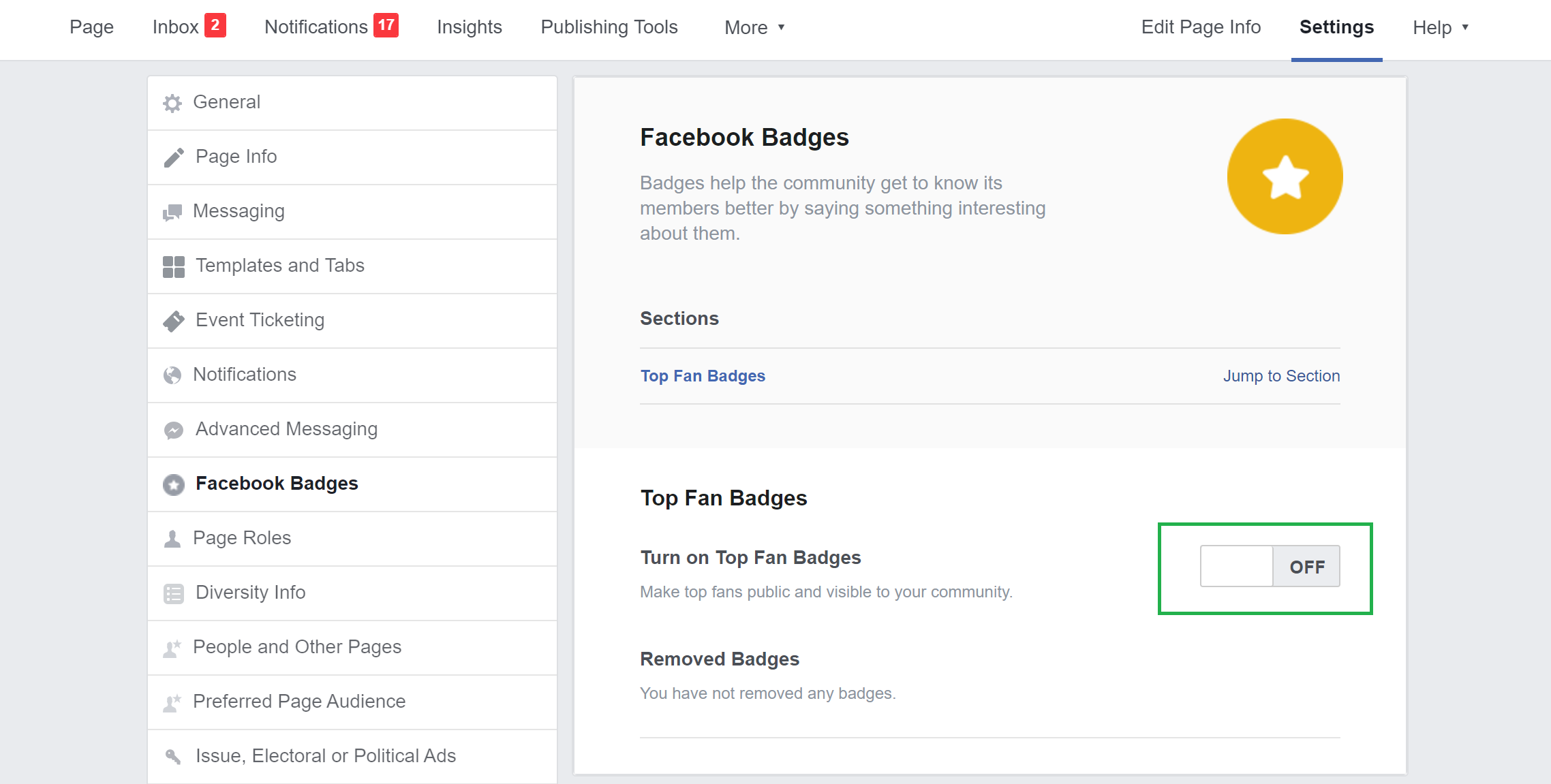
Source: brafton
Levels
“Levelling up” users appeal to their sense of achievement. The thrill of wanting to accrue more points and move up a level to earn bigger and better rewards drives user engagement. For example, Starbucks rewards members with stars for every purchase. 25 stars let customers customise their drinks; 300 stars let customers get a free sandwich.
One of the biggest benefits of this gamification element is that it helps create a sense of customer mastery and purpose. This can further encourage them to continue engaging with the brand.
Leaderboards
This gamification element offers a great way to capture important customer data, such as their names and email addresses. Users engage with the gamified content and make their way up the leaderboard with every accomplishment.
When used in digital marketing, leaderboards can create a sense of competition and social comparison. This taps into the customer’s extrinsic motivation for recognition and social status, which can incentivise them to engage more to improve their ranking. Overall, it offers a fun way to engage with users and stay top of mind.
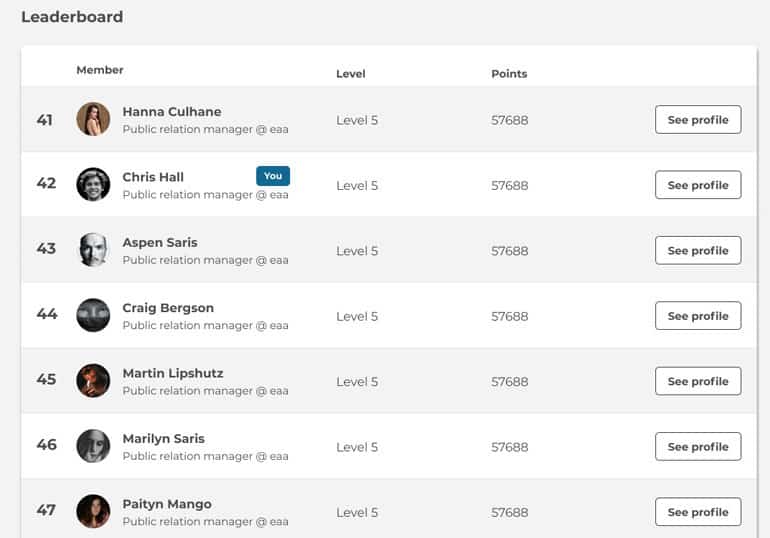
Source: getopensocial
Progress bar
This creates a fun experience as customers track their progress while moving from one level to another. Progress bars are a fun way to help develop a sense of commitment to a particular process.
As a gaming element, the progress bar taps into customers’ intrinsic motivation for mastery and progress. It can also encourage them to continue engaging with a brand by showing how far they’ve come.
Download your free
“108 Gamification Elements and Mechanics”
Get your cheat sheet and have a quick reference at your fingertips!
Countdowns
This is great when the marketing campaign seeks to generate a sense of urgency among the target audience. Customers are essentially incentivised to take action before time runs out.
Countdown timers tap into users’ extrinsic motivation for tangible benefits and rewards. They can also build excitement and generate buzz around a new product or promotion.
Virtual currency
Using virtual currency is a fun way to promote brand engagement. This is when the brand invents its own money to be used only at its stores. Customers can use it to shop now or accumulate the currency for future purchases. It can also be used as a form of reward for loyal customers.
Potential drawbacks to watch out for
While game elements can be highly effective in motivating customers, there are also some potential drawbacks to consider.
For one, some customers may find certain gaming elements to be anxiety-inducing. As an example, leaderboards can often seem intimidating to newer users. They can feel it is hopeless vying for a top spot when the leaderboard rankings are so high. This can have a demotivating effect.
Additionally, not all customers want to play games when browsing a website or social media page.
Lastly, if used consistently over time, game elements can become predictable and eventually lose their “wow” factor. This can significantly decrease customer engagement levels.
For example, a few years back, the eCommerce industry was buzzing about spin-to-win email capture opt-ins. People would put down their email addresses and spin the wheel to win prizes. These ranged from free stuff to premium discounts and free shipping. That was a cool way to capture email addresses, then. And though it is still effective today, the process seems washed out and not so exciting anymore.
Overall, the key to successfully implementing gamified elements in marketing is to carefully consider the target audience’s needs and motivations. This helps brands design experiences that are engaging, rewarding, and aligned with their overall goals and values.
Implementing gamification marketing
Deploying a successful gamification strategy requires data-driven planning. Here’s how to go about it.
#1. Define your goals
Why do you want to apply gamified marketing to your brand? Do you want to increase engagement, drive sales, or perhaps you want to grow brand awareness?
Defining your goals will help you determine the gamification technique and elements that will most effectively achieve them.
#2. Identify your target audience
Who are your target customers? What are their key demographics? What motivates them? Are they driven to take action by intrinsic or extrinsic values? For instance, your gamification approach will likely differ if you’re targeting a younger demographic instead of an older one. Understanding your audience is key to designing a gamification strategy that resonates with them.
#3. Choose game elements
Having defined your marketing goals and mapped out your target audience, it’s time to select the right gamified elements. Will you go for a points-rewards system, or will it be leaderboards and digital badges? Remember to choose game elements based on what will most effectively motivate customers.
#4. Design your gamification strategy
Gamification marketing is all about weaving an interactive game into your marketing strategy. What are the rules of the game? What rewards will customers win? What incentives are you offering?
Whatever your gamification strategy, make sure the game is easy to understand. The game elements must be aligned with your brand values and messaging. Think about the technical requirements of the game. Ideally, it should be playable on both desktop computers and mobile devices. People shouldn’t have to jump through hoops to interact with the game.
#5. Test and refine
Once your gamification strategy is in place, it’s time to deploy and monitor its performance. You may need to refine the gamification technique to keep things interesting for users. This may include tweaking game mechanics or offering new rewards. Analyse your audience’s behaviour and engagement levels and adjust the gamified elements as needed.
Best practices for designing effective gamification experiences
- Keep things simple — Above all, gaming should be a fun experience. And the key to achieving that is by keeping the game mechanics as simple as possible. Yes, the gamified content should be challenging, but in an enjoyable way.
- Set clear goals — Many things gamified marketing can do for your brand. But it is more effective to set your goals to be as specific as possible. Are you looking to grow the numbers in sales? Is this for a brand awareness campaign? Or are you simply looking to increase engagement? The more precise the goal, the easier to track.
- Focus on customer motivations — Prioritise game elements that tap into your customers’ motivations and desires.
- Make it worth their while — Whatever rewards or prizes your gamification strategy offers, make sure they are worth the customer’s time.
- Encourage user feedback — You might need to tweak your gamification marketing efforts now and then. What better way to get relevant market data than from the customers themselves?
- Make it social — Gain free promotion by encouraging users to challenge their friends across social media platforms.
Measuring the success of your gamification efforts
Like any other business investment, you’ll want to ensure your gamification strategy yields the right results. Here are some ways to measure the success of your gamification campaigns:
Track engagement metrics
There are several user engagement metrics that you can track as a way of measuring the success of your gamification strategy. For example, you could follow the number of users who participate in the game. You could also track how much time they spent on the game, as well as what actions they took.
These provide insight into how well the campaign performs and whether users enjoy interacting with the gamified content.
Monitor retention rates
Look at the percentage of users who return to the game. This can help you understand the long-term impact of your gamified marketing on consumer behaviour. A high retention rate indicates that users find the game engaging and valuable. Conversely, a low retention rate could signal a need to refine your gamification marketing strategy.
Measure ROI
Return on investment measures the financial impact of your gamification marketing campaign. This means comparing the costs of developing and promoting the campaign versus how much revenue it generated from increased customer engagement and sales.
Conduct user surveys
User surveys provide valuable feedback on how users perceive the gamified campaign, as well as how it impacted their behaviour. Based on this feedback, you can tweak the game mechanics to provide a better overall user experience.
Gamification marketing case studies
Gamification has come a long way, and the industry is projected to be worth over $95 billion by 2030. That’s saying something about its potential to drive a business forward in a time when marketing has become increasingly personalised.
But why wait until then? Several brands have already incorporated gamification into their marketing campaigns with amazing results. Here are our top three:
KFC Japan’s gamified campaign
In 2021, KFC Japan launched an interactive marketing strategy to drum up hype around a new product on its menu — buttered shrimp. They released an online game called Shrimp Attack to engage customers.
The premise was simple — shrimp are falling from the sky to attack KFC headquarters, and users must swat them away. At the end of the game, players are rewarded with vouchers that can be redeemed at KFC stores.
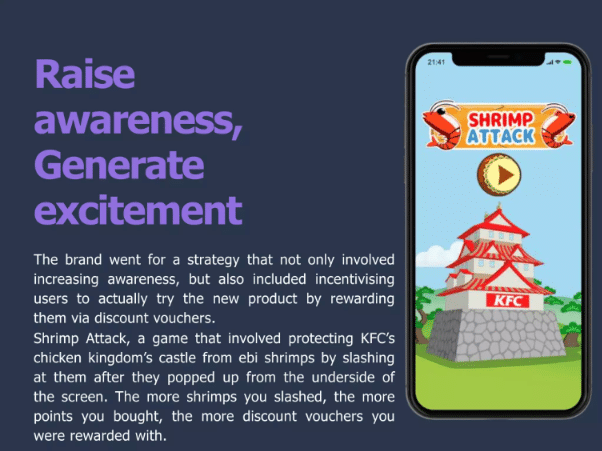
Source: slideshare
Not only did this generate immense brand awareness, but it was a fun way to incentivise customers to try out KFCs new menu item. Store sales skyrocketed as a result and the campaign even had to be adjusted to account for the increased demand.
Pepsi’s AR-powered gamification campaign
In 2020, beverage giant Pepsi launched an AR-driven gamification campaign that featured Lionel Messi, Mo Salah, Paul Pogba, and Raheem Sterling. As some of the biggest names in international football, these players already had strong fanbases, which added to the campaign’s success.
The promotion featured Pepsi cans and Pepsi Black/MAX with limited-edition packaging showing the players. Each can also have a QR code that, when scanned, unlocked AR versions of the players. Users could then participate in a virtual “keepie uppie” game and share their scores across social media.
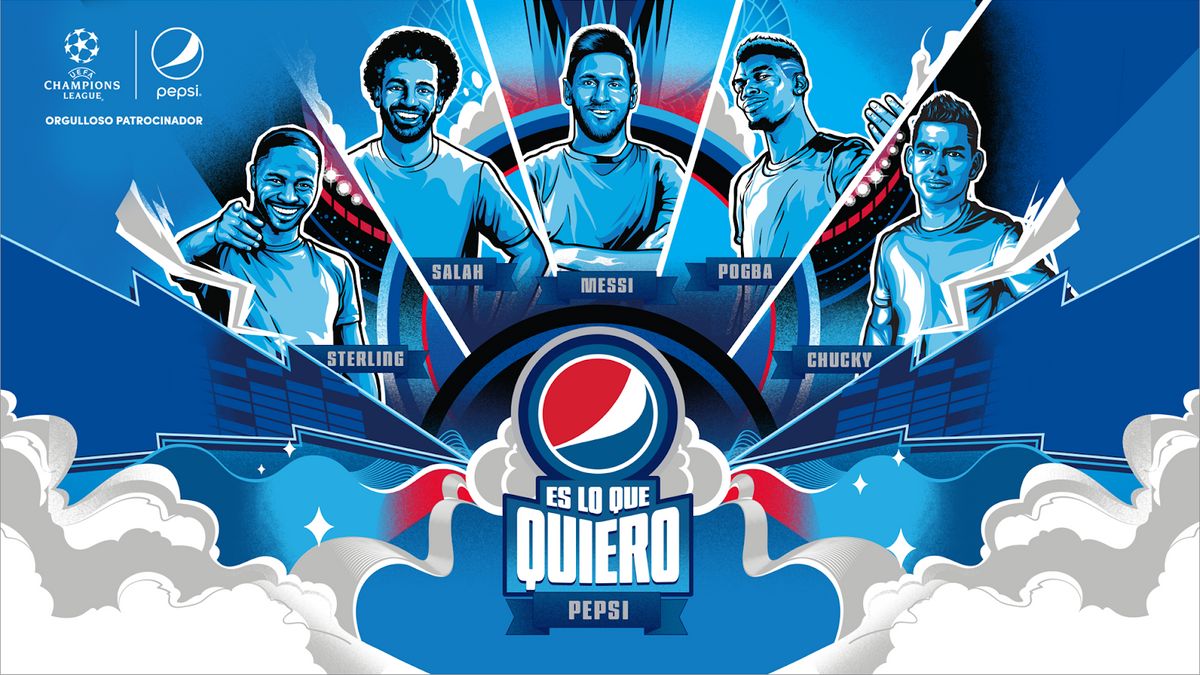
Source: marketingdive
As expected, the campaign drew the interest of football fans from all over the world. More importantly, the game kept users highly engaged, which was obviously one of the main goals of the gamification program.
Under Armour’s Steph IQ trivia game
In 2018, Under Armour ran a gamified campaign to engage users with a Steph IQ quiz application. The trivia game was intended to engage users by asking them general knowledge questions about NBA superstar Steph Curry.
The campaign ran during the 2018 NBA Playoffs and allowed users to enjoy a second-screen experience while watching the live game.
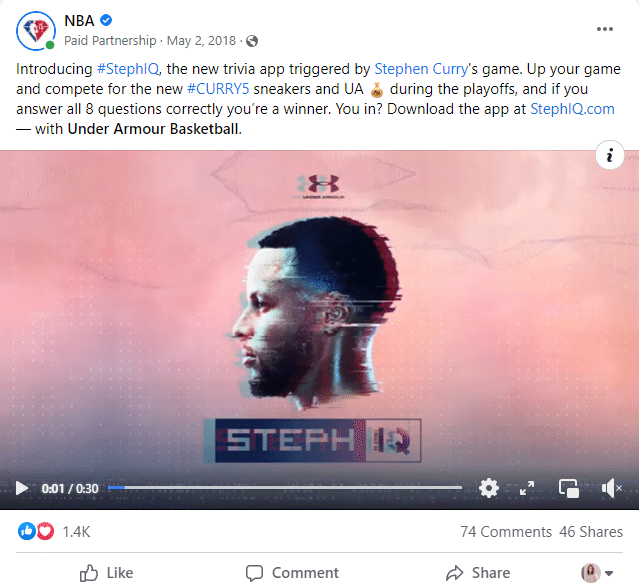
Source: facebook
The game was set up elimination-style, meaning participants who gave a wrong answer were knocked out of the contest. Players who correctly answered all eight multiple-choice questions were rewarded with great prizes. These include Under Armour store credit, Curry 5 footwear, and Golden State Warriors postseason tickets.
Gamification with Mambo.io
Mambo is a leading gamification software designed to help businesses stand out for the right reasons. Engage with users, measure activities, access valuable analytics, motivate employees, and track goals — you can do it all with Mambo.io. Here, we make gamification simple.
The gamification platform boasts several scalable and customisable features to meet the requirements of businesses, whether big or small. It can be deployed across various use cases, including employee onboarding, customer loyalty programs, and call centre engagement.
What makes Mambo.io stand out from other platforms?
- Easy integration — Mambo integrates easily into digital products thanks to its rich REST APIs.
- Powerful engine — The Mambo.io gamification software offers maximum flexibility and a comprehensive lineup of powerful features. The result? A constantly evolving engine that delivers.
- Deployment options— Companies don’t have to set up or run the infrastructure. They can leverage Mambo’s on-demand services and dedicated cloud options to get their gamification strategy up and running quickly.
- On-premise — Mambo offers on-premise gamification infrastructure setups. This is an ideal solution for organisations bound by stringent data privacy regulations.
- Extensible — Mambo.io’s gamification software can be extended to handle specific functions.
Key takeaways
- Gamification marketing involves using game elements, such as points, badges, levels, and rewards, to engage and motivate customers.
- By tapping into customers’ motivations, gamification marketing can help create a sense of accomplishment, enjoyment, and competition.
- Successful gamified campaigns have demonstrated increased customer engagement, improved brand loyalty, and higher conversion rates.
- Designing effective gamification experiences requires setting clear goals, offering quality rewards, identifying the audience, and choosing the right game elements.
- Brands must also continually refine their gamified strategies based on market data and customer feedback.
- Engagement metrics, retention rates, and user surveys are among the best ways to measure the success of your gamification campaign.
Closing thoughts
Gamification has proven to be a valuable asset in brand marketing. So if you’re still on the fence about it, now may be the time to consider it more thoroughly.
At the end of the day, the best gamification technique is the one that best aligns with your brand values and delivers results. The key to getting it right is working with a highly-skilled developer team to design the perfect games for your target audience.
If you’d like to explore the world of gamification marketing further, get straightforward data visualisation for gamification in Mambo’s infographics section.
Latest Posts
Machine Learning In Finance: 12 Essential Applications
The impact of machine learning on finance is significant. Thanks to this technology, financial institutions are now equipped to make efficient decisions. Through the analysis of data sets, machine learning […]
How To Create Interactive Compliance Training For Bank Employees
Banking compliance training isn’t just another task. It’s the stage where everything else performs. Banks must navigate a myriad of regulations and laws. After all, this is a trust-driven, high-stakes […]
How Fintech Apps Are Using Gamification To Increase User Engagement
Discover how gamification in fintech is revolutionizing financial engagement, making banking fun & boosting user loyalty.






